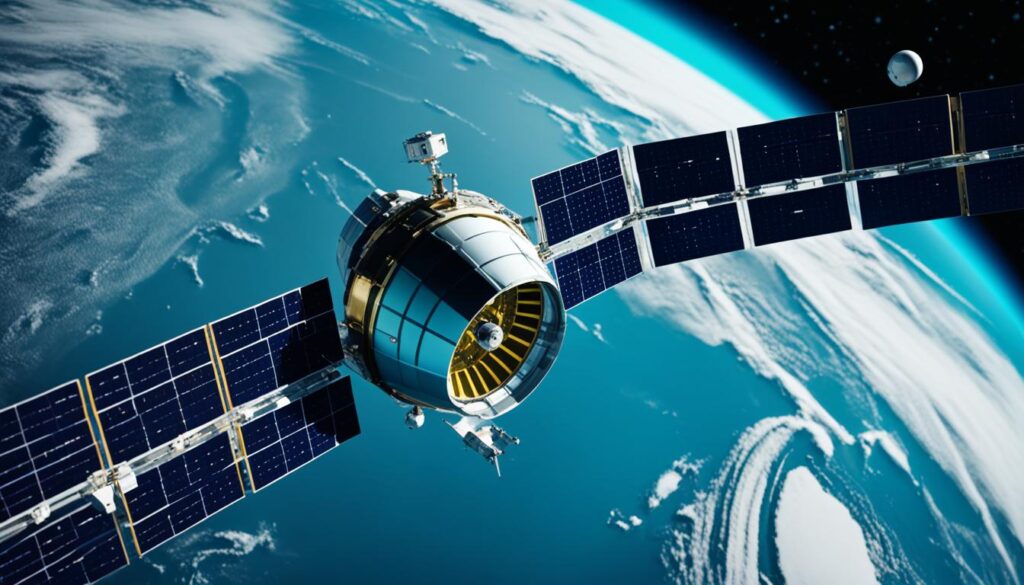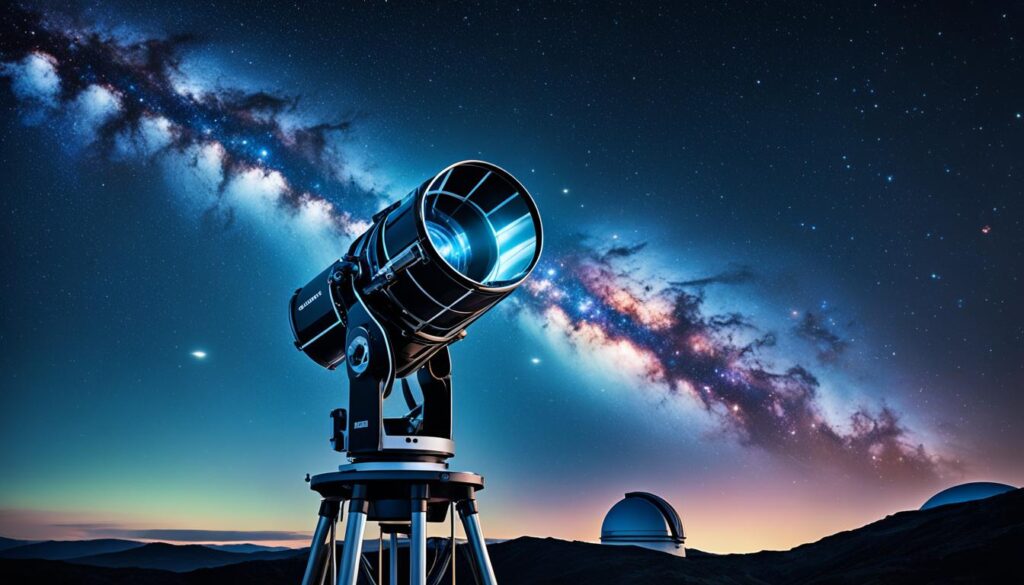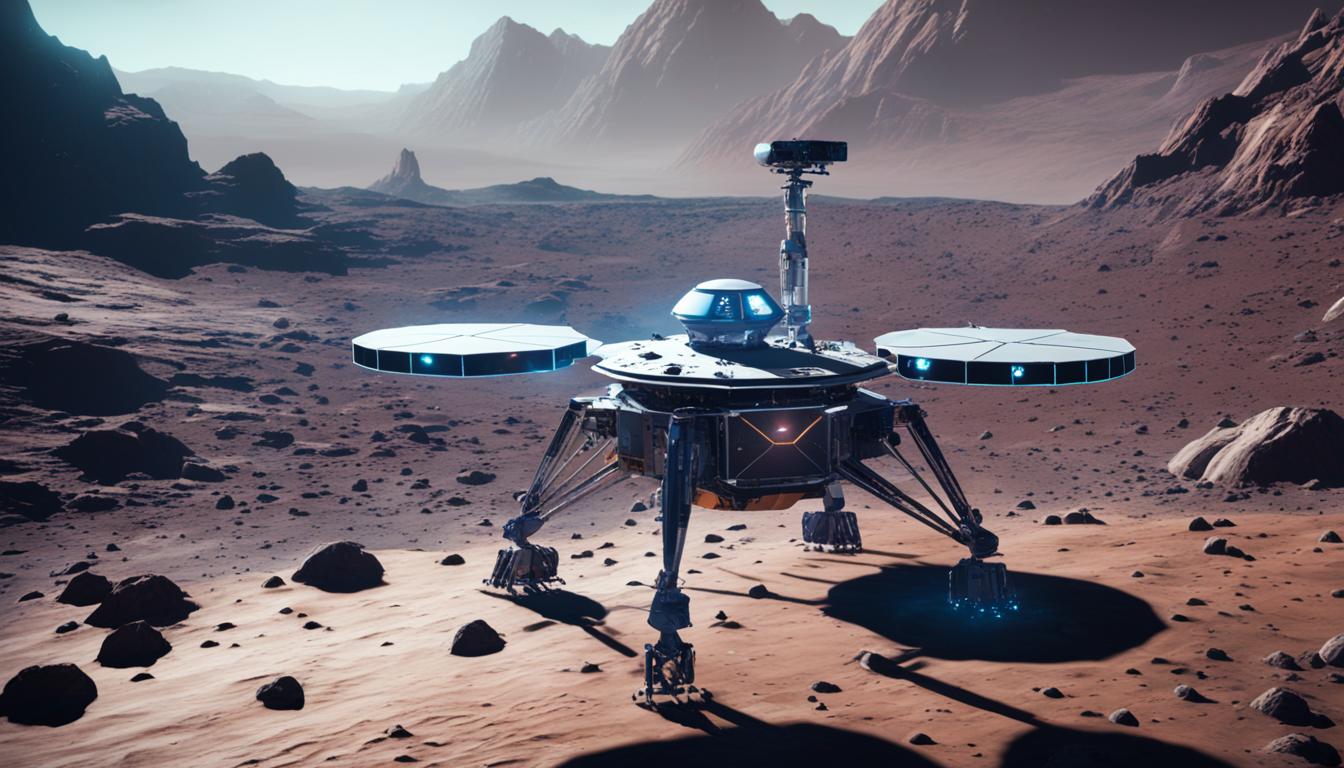Artificial intelligence (AI) is revolutionizing space exploration, pushing the boundaries of what is possible in the quest for interstellar discovery. AI advancements in space technology, such as machine learning and robotics, are transforming various aspects of space missions, enhancing efficiency, safety, and data analysis. From autonomous rovers to satellite operations and rocket landing technology, AI is shaping the future of space exploration.
Machine learning algorithms, fueled by AI, enable rovers like NASA’s Perseverance to autonomously navigate extraterrestrial terrains, like the Martian surface. AI-driven navigation systems analyze sensor data in real-time, choosing the best path and avoiding obstacles, ensuring the safe exploration of uncharted territories.
In satellite operations, AI algorithms play a critical role in collision avoidance. Autonomously detecting and avoiding orbital debris and hazards, AI ensures safe navigation for satellites like SpaceX’s Starlink. Additionally, AI optimizes fuel usage and trajectory adjustments, streamlining operations and maximizing efficiency.
Data analysis is another area where AI excels in space exploration. By processing vast amounts of cosmic data collected from satellites and probes, AI algorithms provide more precise insights, identify patterns, classify celestial objects, and even predict future events. This accelerates our understanding of the universe and opens new horizons for scientific exploration.
Furthermore, AI integration in rocket landing technology ensures optimal landing positioning and enhanced success in missions that require controlled landing on celestial bodies. By analyzing real-time sensor and camera data, AI systems make necessary adjustments to trajectories, considering variables like wind and atmosphere, ultimately improving the safety and precision of rocket operations.
AI has also revolutionized the mapping of stars and galaxies. AI-based algorithms accurately identify celestial objects, detect patterns in star clusters, classify features, and predict behaviors over time. This predictive analysis provides scientists with valuable insights for future mapping and exploration missions.
Key Takeaways:
- AI is revolutionizing space exploration across various aspects of missions.
- Autonomous rovers equipped with AI-driven navigation systems enable safe exploration of extraterrestrial terrains.
- AI algorithms enhance satellite operations, ensuring collision avoidance and optimizing fuel usage.
- AI-driven data analysis accelerates our understanding of the universe, providing precise insights and predictions.
- Integration of AI in rocket landing technology improves safety and precision in rocket operations.
Autonomous Rovers in Space Exploration
The use of AI in autonomous rovers is revolutionizing space exploration, particularly on extraterrestrial bodies like Mars. NASA’s Curiosity and Perseverance rovers are prime examples of AI-driven navigation systems that analyze sensor data to determine the best path forward and avoid obstacles. By leveraging advanced AI algorithms, these rovers can safely navigate the treacherous Martian terrain, collecting valuable data on the planet’s composition and unlocking insights about its geological history.
One of the remarkable advancements in AI-driven navigation is demonstrated by NASA’s Perseverance rover. Equipped with an innovative AI software called Autonomous Exploration for Gathering Increased Science (AEGIS), Perseverance can autonomously identify and classify different types of rocks and features on the Martian surface. This AI-driven analysis streamlines the rover’s operations and enables efficient data collection, contributing to a wider understanding of Mars’ geology and potential for hosting past or present forms of life.
AI-powered autonomous rovers have proven to be instrumental in overcoming the challenging conditions present in space exploration. With their ability to analyze data, make informed decisions, and adapt to dynamic environments, these rovers serve as invaluable tools in our quest for scientific exploration and discovery.
AI in Satellite Operations
Artificial intelligence (AI) is revolutionizing satellite operations, enhancing efficiency and safety in space navigation. With the advent of AI algorithms, satellites are equipped with autonomous collision avoidance systems that protect them from potential collisions with orbiting debris and other hazards. This advanced technology ensures the safe navigation of satellites and the preservation of valuable space assets.
One notable example of AI-driven satellite operations is SpaceX’s Starlink project. Powered by AI algorithms, Starlink satellites utilize real-time data analysis to detect and avoid potential collisions. By adjusting their speed and trajectory, these satellites can swiftly adapt to changing conditions, ensuring their safe passage through space.
In addition to collision avoidance, AI plays a crucial role in optimizing fuel usage for satellites. By leveraging AI algorithms, engineers can analyze real-time data on various factors such as weather conditions and orbital dynamics to optimize fuel consumption, prolonging the lifespan of satellites and enabling more extended missions.
Furthermore, AI algorithms contribute to trajectory adjustments for satellites, allowing them to maintain their intended paths and orbits. These adjustments are essential for precise positioning and coordinated movements of satellite constellations, such as SpaceX’s Starlink, which require careful planning and synchronization. The application of AI in trajectory adjustments ensures smooth operations and minimizes the risk of collisions or interference between satellites.

The Benefits of AI in Satellite Operations
The integration of AI in satellite operations brings several benefits to space exploration and navigation:
- Enhanced Safety: AI algorithms enable real-time collision avoidance, protecting satellites from potential hazards and preserving valuable space assets.
- Efficient Fuel Usage: By optimizing fuel consumption, AI algorithms contribute to extending the lifespan of satellites and enabling longer missions.
- Precise Trajectory Adjustments: AI-driven trajectory adjustments ensure accurate positioning and coordinated movements of satellite constellations, reducing the risk of collisions and interference.
Sample Table: AI Applications in Satellite Operations
| AI Application | Description |
|---|---|
| Collision Avoidance | AI algorithms analyze real-time data to detect and avoid potential collisions with orbital debris and other hazards. |
| Fuel Usage Optimization | AI algorithms optimize fuel consumption, prolonging the lifespan of satellites and enabling longer missions. |
| Trajectory Adjustments | AI-driven trajectory adjustments ensure precise positioning and coordinated movements of satellite constellations. |
AI in Data Analysis for Space Missions
Data analysis is a critical component of space missions, allowing scientists to uncover valuable insights from the vast amounts of data collected from satellites, probes, and other space exploration tools. With the advent of artificial intelligence (AI) algorithms and machine learning, data analysis in space missions has become more precise and efficient, paving the way for groundbreaking discoveries.
AI algorithms excel at identifying patterns and classifying celestial objects, enabling scientists to better understand the composition, behavior, and interactions of these objects. Machine learning algorithms can detect anomalies in the data, helping scientists uncover unexpected phenomena and further expand our knowledge of the universe.
The power of AI-driven data analysis lies in its ability to process and interpret massive amounts of data quickly and accurately. This allows scientists to make real-time decisions based on precise analysis, optimizing the efficiency of space missions and maximizing the scientific output.
Precise Analysis of Celestial Objects
One area where AI algorithms shine is in the precise analysis of celestial objects. By training machine learning models on vast datasets, scientists can automate the identification and categorization of stars, galaxies, and other celestial bodies. This not only speeds up the analysis process but also ensures consistency and accuracy in classifying these objects.
With AI-powered data analysis, scientists can delve deeper into the universe, uncovering the intricate details of celestial objects that may have previously gone unnoticed. By mapping the relationships between stars and galaxies, scientists can gain a clearer picture of the cosmic structure and evolution.
“AI algorithms have revolutionized our ability to analyze and understand the vast amounts of data we collect from space missions. With the help of machine learning, we can process this data faster and with greater accuracy, opening up new possibilities for scientific exploration.” – Dr. Amanda Rodriguez, Astrophysicist
Unlocking Deeper Insights from Cosmic Data
AI-driven data analysis not only accelerates our understanding of the universe but also unlocks deeper insights from the cosmic data. By leveraging machine learning algorithms, scientists can predict the occurrence of celestial events and phenomena, allowing for targeted observations and maximizing the scientific yield.
Furthermore, AI algorithms can identify correlations and patterns in the data that human analysts may overlook. This can lead to the discovery of new cosmic phenomena and provide fresh perspectives on existing theories and models.
Sample Table (Space Mission Data Analysis)
| Space Mission | Data Analyzed | AI Techniques Used |
|---|---|---|
| Mars Rover Missions | Surface Composition, Weather Patterns | Machine Learning, Image Recognition |
| Hubble Space Telescope | Galaxy Classification, Dark Matter Detection | Deep Learning, Pattern Recognition |
| Planck Satellite | Cosmic Microwave Background Radiation | Neural Networks, Statistical Analysis |
Through AI-driven data analysis, space missions are uncovering new insights, pushing the boundaries of our understanding of the cosmos. As AI algorithms continue to evolve and improve, we can expect even more precise and efficient analysis of cosmic data, leading us to new frontiers of interstellar discovery.

AI in Rocket Landing Technology
The integration of AI in rocket landing technology has revolutionized the safety and precision of rocket operations in space. Companies like SpaceX have successfully incorporated AI systems to analyze sensor and camera data in real-time, enabling the rocket to make crucial calculations and adjustments during the landing process. By considering variables such as wind speed and atmospheric conditions, the AI system ensures optimal landing positioning, significantly enhancing the success rate of space missions that require rocket landing or controlled landing on celestial bodies.
The AI integration in rocket landing technology enables real-time adjustments, allowing the rocket to respond dynamically to changing conditions during descent. This capability eliminates the need for manual intervention and provides a level of accuracy and responsiveness that was previously unattainable. The AI-driven system constantly evaluates incoming data, making precise calculations to ensure a safe and controlled landing.
One of the key advantages of AI in rocket landing technology is the ability to adapt to unforeseen circumstances. The AI systems can quickly identify anomalies and adjust the landing trajectory accordingly, mitigating potential risks. These real-time adjustments improve the safety of both the rocket and surrounding assets, reducing the chances of accidents or collisions.
The Benefits of AI in Rocket Landing Technology
“The integration of AI in rocket landing technology has revolutionized the safety and precision of rocket operations in space. By utilizing AI systems to analyze real-time data and make adjustments, rockets can achieve optimal landing positioning, ensuring successful space missions.”
Furthermore, AI enables continuous learning and improvement in rocket landing technology. As more data is collected and analyzed from each landing attempt, the AI systems can refine their algorithms and enhance their understanding of optimal landing strategies. This iterative process contributes to the overall progress of rocket landing technology and paves the way for more ambitious space exploration missions.
The role of AI in rocket landing technology cannot be overstated. By integrating AI systems, space agencies and private companies alike can improve the safety, precision, and success rate of rocket landings, enabling a new era of space exploration.
| Advantages of AI in Rocket Landing Technology | Benefits |
|---|---|
| Real-time adjustments | Ensures optimal landing positioning |
| Adaptability | Responds to unforeseen circumstances and mitigates risks |
| Continuous learning | Refines algorithms and improves landing strategies |

AI in Mapping Stars and Galaxies
AI has revolutionized the mapping and understanding of stars and galaxies in space. By leveraging AI-based algorithms and data collected from telescopes such as NASA’s Kepler, scientists can accurately identify celestial objects and gain valuable insights into the vast expanses of our universe.
“The ability of AI algorithms to analyze immense amounts of astronomical data has opened new doors for galaxy mapping and exploration,” says Dr. Sophia Ramirez, a leading astrophysicist at the Kepler Science Institute.
One of the remarkable capabilities of AI is its ability to detect patterns in star clusters. By analyzing the data with AI algorithms, astronomers have been able to identify the characteristics of different star formations and gain a deeper understanding of their evolution. This knowledge provides crucial insights into the processes that shape galaxies and the formation of stars.
Additionally, AI-based algorithms can classify features in deep space, allowing astronomers to categorize and study various celestial objects. From identifying different types of galaxies to classifying the spectral signatures of stars, AI plays a vital role in aiding our understanding of the cosmos.
The predictive power of AI is particularly valuable in mapping stars and galaxies. Through predictive analysis, AI algorithms can forecast the future behavior of stars and galaxies, providing astronomers with valuable information for future mapping and exploration missions.
Dr. Ramirez notes, “AI’s predictive analysis enables us to simulate the movement and interactions of stars and galaxies over time, helping us explore the vast reaches of the universe with greater accuracy and efficiency.”
The Kepler Telescope: Advancing Galaxy Mapping with AI
The Kepler telescope, launched by NASA in 2009, has been instrumental in expanding our understanding of exoplanets and star systems. Equipped with advanced AI algorithms, the Kepler telescope has detected and classified numerous celestial objects, including potentially habitable exoplanets.

The combination of the Kepler telescope and AI-driven analysis has led to groundbreaking discoveries, such as the identification of exoplanets within the habitable zones of distant star systems. This discovery has fueled excitement and curiosity about the possibility of extraterrestrial life.
AI’s Contribution to Galaxy Mapping
| Advancement | Description |
|---|---|
| Accurate Celestial Object Identification | AI-based algorithms accurately identify stars, galaxies, and other celestial objects, enabling precise mapping and analysis. |
| Pattern Recognition in Star Clusters | AI algorithms detect patterns in star clusters, providing insights into their formation and evolution. |
| Classification of Celestial Features | With AI, astronomers can categorize and study different types of galaxies, stars, and other features in deep space. |
| Predictive Analysis for Future Mapping | AI’s predictive capabilities enable astronomers to forecast the behavior and interactions of stars and galaxies, aiding future mapping missions. |
Thanks to AI-driven technologies like the Kepler telescope and advanced algorithms, galaxy mapping has become more accurate and comprehensive than ever before. These advancements have unlocked new insights into the formation, evolution, and behavior of stars and galaxies, paving the way for future discoveries and a deeper understanding of our universe.
Conclusion
Artificial Intelligence (AI) is revolutionizing space exploration, paving the way for a future of AI-driven discovery and interstellar exploration. From the autonomous rovers on extraterrestrial bodies to AI-powered satellite operations, data analysis, rocket landing technology, and mapping stars and galaxies, AI advancements are transforming our understanding of the cosmos.
The integration of AI in space exploration has significantly enhanced the efficiency and safety of missions. AI-driven autonomous rovers like NASA’s Perseverance can navigate the treacherous Martian terrain and collect valuable data, while AI algorithms in satellite operations ensure safe navigation and collision avoidance. Furthermore, AI-powered data analysis enables us to process and interpret vast amounts of cosmic data, accelerating our understanding of the universe.
With AI as a valuable tool in space exploration, the future holds immense potential for uncovering the mysteries of the universe. AI-driven missions will continue to push the boundaries of interstellar discovery, enabling us to venture into new frontiers and gain deeper insights into the cosmos. As AI technology evolves, humanity’s exploration of space will be propelled forward, opening up avenues for remarkable discoveries and advancements in our understanding of the universe.
FAQ
How is AI being used in space exploration?
AI is being used in various ways in space exploration, including autonomous rovers, satellite operations, data analysis, rocket landing technology, and mapping stars and galaxies.
What are autonomous rovers in space exploration?
Autonomous rovers are robotic vehicles equipped with AI-driven navigation systems that analyze sensor data to safely navigate extraterrestrial terrain and collect valuable data on celestial bodies like Mars.
How does AI assist satellite operations in space exploration?
AI algorithms enable satellites to detect and avoid potential collisions with orbital debris and other hazards, ensuring safe navigation and protecting space assets. AI also optimizes fuel usage and trajectory adjustments.
What role does AI play in data analysis for space missions?
AI provides more precise and efficient methods of processing and interpreting vast amounts of data collected in space, enabling machine learning algorithms to identify patterns, classify celestial objects, detect anomalies, and predict future events.
How does AI enhance rocket landing technology in space exploration?
AI systems analyze real-time sensor and camera data to make calculations and adjustments during rocket operations, ensuring optimal landing positioning considering variables such as wind and atmosphere.
How does AI contribute to mapping stars and galaxies in space exploration?
AI-based algorithms accurately identify and classify stars, galaxies, and other celestial objects, detecting patterns in star clusters, classifying features in deep space, and even predicting the behavior of stars and galaxies over time.
What is the future of AI in space exploration?
AI-driven missions are pushing the boundaries of interstellar discovery, and as AI continues to evolve, it holds great promise for unraveling the mysteries of the universe and venturing into new frontiers.








